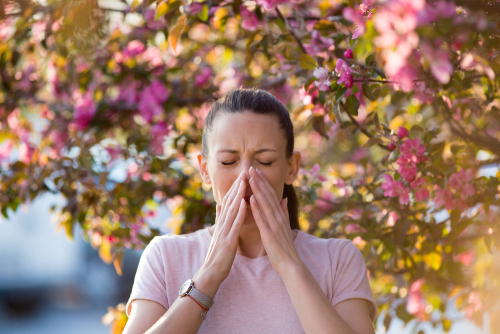


While spring is a beautiful time of year, for many Australians, the new season welcomes some unwanted allergies as a result of plants releasing pollen. Every year, millions of people with hay fever start to sniffle and sneeze and cannot control it. However, there are some steps you can take to curb the spring time allergies, ranging from medication to household habits.
Here’s what you need to know.
Causes
The biggest and most common trigger for spring-related allergies is pollen. Whether it’s from trees, grasses, weeds, or flowers, the tiny grains that fill the air get into people’s airways and send the body’s defences haywire. This reaction is due to the immune system mistakenly seeing the pollen as a danger, and as a result, the body releases antibodies to attack the allergens. The result of this is a release of chemicals called histamines into the blood stream. These histamines are the cause behind the runny nose, itchy eyes, and other symptoms that are all too familiar to hay fever sufferers.
Pollen can travel over great distances so it’s not just about the plants in your neighbourhood. Some of the most common plants that can trigger pollen related reactions includes:
Trees
- Cedar
- Cottonwood
- Cypress
- Elm
- Juniper
- Maple
- Mulberry
- Oak
- Pine
- Sycamore
Grasses and weeds:
- Fescue
- Johnson
- June
- Orchard.
Pollen counts tend to be higher on windy days when the wind picks up pollen and carries it through the air. On the other hand, rainy days wash away the allergens, lowing the pollen count drastically.
Symptoms
There are many symptoms that you could experience if you suffer from seasonal allergies, including:
- Runny nose
- Watery eyes
- Sneezing
- Coughing
- Itchy eyes and nose
- Dark circles under and around the eyes.
Diagnosis
If you want a diagnosis to check if you suffer from seasonal allergies, start with your regular doctor. They may refer you to an allergist for tests.
The allergy specialist may give you a skin test, which can involve pricking the skin with a tiny amount of the allergen. This is known as the prick test.
The allergist may also inject a tiny sample of a diluted allergen solution under the skin on your arm or back. If you are allergic to the substance, a small red bump, called a wheal or hive, will form. Sometimes, you may need blood tests for further diagnosis.
Solutions
As for solutions to seasonal allergies, there are many medicines that can ease or even stop the symptoms you are experiencing. These can include:
- Antihistamines: They can reduce sneezing, sniffling, and itching by lowering the amount of histamines coursing through your body.
- Decongestants: They can shrink the blood vessels in the nasal passageways to relieve congestion and swelling in your head.
- There are drugs that combine the effects of both antihistamines and decongestants. For more information, ask your local GP.
- Nasal spray decongestants: Spray decongestants relieve congestions and can clear clogged nasal passages faster than oral decongestants without some of the side effects.
- Steroid nasal sprays ease inflammation: These are the preferred initial treatment. Only three, budesonide (Rhinocort Allergy), fluticasone (Flonase), and triamcinolone (Nasacort Allergy), are available over the counter. Cromolyn sodium nasal spray can help prevent hay fever by stopping the release of histamine before it can trigger allergy symptoms.
- Eye drops: Can help to relieve irritated, itchy, watery eyes and are generally available over the counter.
Even though you can buy these allergy drugs without a prescription, it is a good idea to consult your doctor to make sure the medication is the right choice for your symptoms. Some antihistamines can leave you feeling drowsy, so be careful what type you take during the day. If you feel like you need more than a few days’ worth of antihistamines and decongestants, talk to your doctor as there are other, longer-term options for controlling your symptoms.
Some doctors may recommend under-the-tongue immunotherapy tablets. Immunotherapy delivers gradually increasing doses of the allergen until your body no longer reacts. The treatment can relieve your symptoms for a longer time than other forms of allergy medications.
There are also several natural remedies for allergies. Nasal irrigation uses a combination of warm water, salt and baking soda to clear out mucus and open the sinuses. To do this, you can use a squirt bottle or a neti pot. Some other methods include:
- Butterbur – A herb which comes from a European shrub. Studies show that a specifical extract called Ze 339 works as well as some antihistamines.
- Quercetin – A nutrient found in onions, apples and black tea. It has been found to block the release of histamines into the blood.
Before trying to treat your hay fever symptoms with herbal solutions, make sure to consult your doctor first.
Do you, or anyone you know, suffer from hay fever symptoms?




